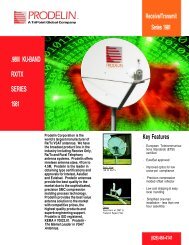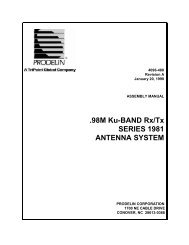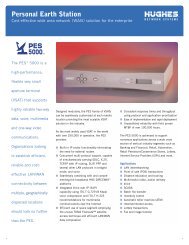SUMMARY CHARACTERISTICS OF THE W SATELLITES
SUMMARY CHARACTERISTICS OF THE W SATELLITES
SUMMARY CHARACTERISTICS OF THE W SATELLITES
Create successful ePaper yourself
Turn your PDF publications into a flip-book with our unique Google optimized e-Paper software.
w_(iss6.3_jan03).doc - 6 -<br />
The W Satellites<br />
• Channels D1, D3, D1S and D3S can each receive from either the fixed coverage or the steerable coverage,<br />
the choice of uplink coverage being made on a channel-by-channel basis.<br />
• Channels D5, D7, D5S and D7S can each receive from either the fixed coverage or the steerable coverage,<br />
or simultaneously from both coverages, the choice of operational mode being made on a channel-by-<br />
channel basis.<br />
The eight channels with cross-connection capability are identified in Figure 1. The following operational<br />
possibilities are provided for all eight channels:<br />
• A signal received from one coverage (fixed or steerable) can be transmitted to the other coverage. For<br />
example, the channel pair D3 and D3S could be used to provide bi-directional communication between the<br />
fixed coverage and the steerable coverage.<br />
• A signal received from any given coverage can be simultaneously transmitted to both coverages. For<br />
example, the channel pair D1 and D1S could be used to “broadcast” the same signal received from the<br />
steerable coverage to both the fixed and steerable coverages.<br />
In addition, Channels D5, D7, D5S and D7S each provide the possibility to receive signals from both coverages<br />
and to transmit them to a single coverage or to both coverages. In this case, performance in terms of G/T takes<br />
into account the wider uplink coverage and discrimination between uplink carriers must be ensured through<br />
FDMA (i.e. the spectra of the carriers must not overlap).<br />
For example, the lower half of the 54 MHz bandwidth occupied by the channel pair D5/D5S could be used to<br />
receive traffic from the fixed coverage whilst the upper half could be used to receive traffic from the steerable<br />
coverage. The combined traffic could then be transmitted to the fixed coverage via Channel D5 and<br />
simultaneously to the steerable coverage via Channel D5S. This type of networking between two different<br />
coverages can offer attractive mission features for certain types of services.






